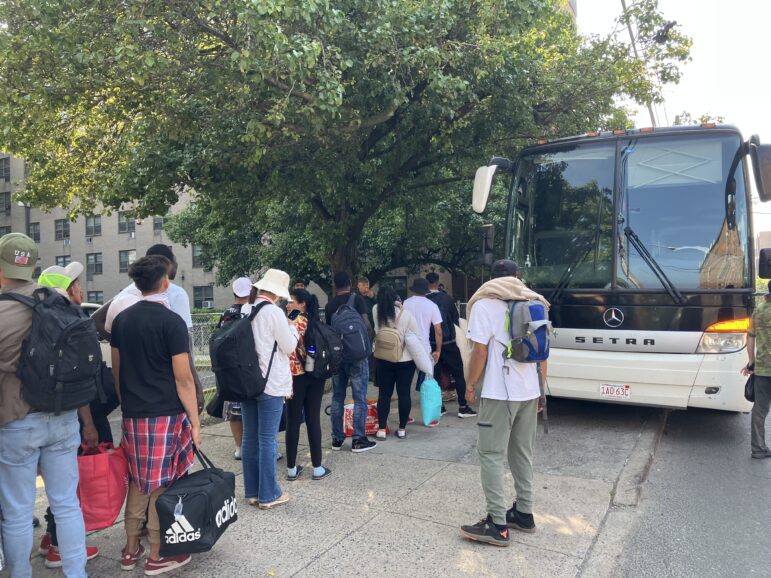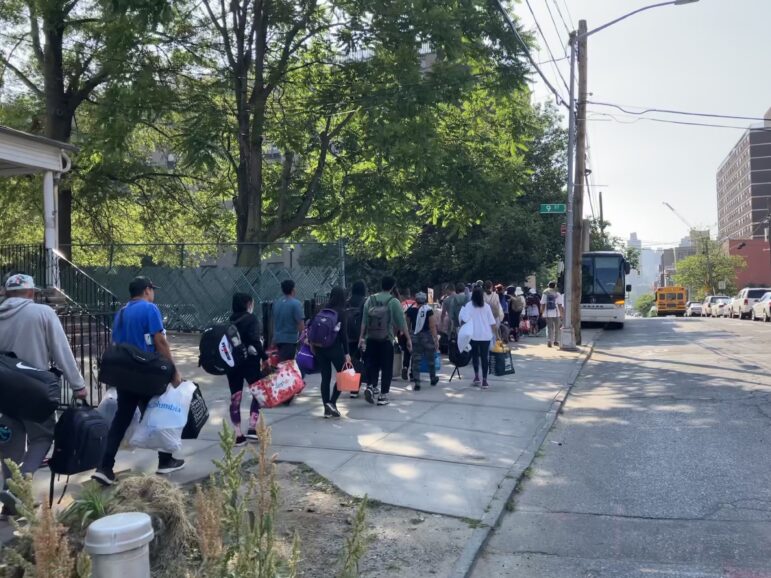On Wednesday afternoon, two buses carrying more than 60 people from city shelter left for the Ramada Inn in Albany, where officials say they’re also nearing capacity. Those who opted to leave include asylum seekers who’d spent weeks in one of the city’s respite centers, where services are limited and future placements are uncertain.

Daniel Parra
Asylum seekers lined up in Queens last week for a bus to Albany.Lea la versión en español aquí.
A group of young immigrant asylum-seekers waited, chatting and smoking cigarettes outside St. Margaret Mary’s Catholic Church in Astoria last week, one of eight “respite centers” Mayor Eric Adams’ administration has opened this spring—threadbare shelter sites intended for temporary stays, though several at the Queens location said they had been there for weeks.
Two buses were scheduled to arrive that afternoon to take those staying there to Albany, if they chose to go.
“It’s the capital,” one member of the group said in Spanish, considering work availability in the upstate city—among several counties outside the five boroughs where Adams has sought to relocate migrants in recent weeks, saying his administration can no longer shelter them all on its own.
Asylum seekers staying at the Queens church were given the option of remaining in the city or voluntarily boarding a bus for a chance at more comfortable lodgings at the Ramada Inn on Albany’s Watervliet Avenue. More than 60 people chose to leave.
“I was shown pictures of the hotel, it’s nice,” a man staying at the respite facility said of the offer. “And it has a bed, real beds,” he added, slowing down the last two words for emphasis. At the church, he and others had been sleeping on cots, and had to walk to facilities in nearby Astoria Park to shower.
After initial communication problems, the first bus with approximately 40 asylum seekers sent by the mayor arrived in Albany during Memorial Day weekend, Albany Mayor Kathy Sheehan announced.
As of June 2, the city of Albany had received about 215 people bussed from New York City shelters, said the Albany mayor’s Chief of Staff, David Galin. “We’re not there yet,” Galin said last week when asked about the maximum number of immigrants the capital city could handle while offering optimal services, “but we’re getting there.”
“We are reaching a point where our non-profit partners need more time to keep up with the intake of the 215 asylum seekers who are in Albany—which is more than the approximately 200 [that] was stated by our nonprofit partners as a benchmark that they could quickly help support,” Galin said via email.

Daniel Parra
Immigrants lining up to board the bus for Albany, from Queens on Wednesday, May 31.Meanwhile, in New York City, “respite centers” overseen by the Office of Emergency Management (OEM) are supposed to be for very short-term use. They offer even more limited services than other emergency shelters the city has rushed to open in recent months—157 of them in total, including nine Humanitarian Emergency Response and Relief Centers (HERRCs).
When asked, City Hall did not provide a specific date for when the St. Margaret Mary site opened to migrants, but said respite centers are generally intended to serve as temporary waiting rooms for asylum seekers when the city receives an influx of new arrivals or runs out of space.
However, more than a dozen of those sleeping at the Astoria church told City Limits during a visit last Wednesday that they’d been there for more than two weeks, and a few were about to complete four weeks at the site.
Mayor Adams’ administration has been calling for a “decompression strategy” at the border for months. But within city limits, he’s embarked on a strategy of decompressing local shelters by sending immigrants to other localities in New York State and paying to shelter them there, while turning the legal screws to change local “right to shelter” rules which require the city to provide an overnight bed for anyone who needs it.
The administration opened its first of what it’s calling a “respite center” last month, at the NYPD’s former Manhattan police academy building on 20th Street, where families with minors were placed for days in apparent violation of those right to shelter standards, City Limits reported at the time. Advocates and lawmakers have criticized the mayor’s efforts to weaken those protections.
“Doing so would relegate vulnerable people, longtime New Yorkers and recent migrants alike, to sleeping in public and unsafe spaces: on sidewalks, in parks, in the transit system, or returning to homes with people who have harmed them,” Legal Aid Society said in a recent statement.
There are more than 46,000 migrants currently in the city’s care, Deputy Mayor Anne Williams-Isom said during a briefing last week, with over 72,000 arriving at intake centers since last year. However, City Comptroller Brad Lander has asked the administration for more detailed data on the migrant population after he said City Hall stopped sharing such breakdowns.
According to Williams-Isom, last week alone the city received 2,200 new asylum seekers.
At St. Margaret Mary’s, there were single men, single women, and couples staying at the site. And while the mayor’s office says that their goal is to move people from respite centers as soon as an alternative placement is found, many at the church said they have asked to be moved to another location but were told it’s not possible.
For example, Yorgelys, who preferred not to give her last name, said she arrived at St. Margaret Mary’s 24 days ago. After hearing that some asylum seekers who had gone to the city’s “Arrival Center” at the Roosevelt Hotel in Manhattan were able to access a room there, or in another hotel, she decided to try her luck: Yorgelys returned to the intake site last Tuesday to reapply.
But Yorgelys and her partner were told to return to the respite center, and after spending the night in the lobby of another Manhattan hotel shelter, were transported back to the Astoria church the next day on an MTA bus, along with other couples and other immigrants being brought there.
Carolina Martínez, among a group of single women who’d been staying in the respite center, said she signed up to relocate to the Albany hotel because, after two weeks staying in a facility without an on-site shower, she still hadn’t adjusted.
“I became friends with a Dominican lady who brings me food and lets me have a bath in her apartment,” said Martínez, 24.
Asylum seekers who left on the bus said they were told they could stay at the hotel in Albany for up to four months. Galin could not confirm those details, but noted that the laws there allow people to stay more than 28 days in a hotel, unlike other municipalities.
One woman who gave her first name as Jessica said she and her husband had initially volunteered to be transported to Albany, but approached a shelter staff member and interpreter Wednesday to ask if they could stay in New York City after all—Jessica’s husband had just received a local job offer. But shelter staff said it was too late to change course.
“Tell them they’re making it hard for us because we can’t discharge and put them back, especially on the same exact day,” the shelter staffer said to an interpreter who translated the information for the couple. The pair would first have to leave the “Albany system” before they could re-could rejoin the respite center “system,” according to the staff member.
“They have to go upstate because they already signed off,” the staffer said.
Minutes later, Jessica and her husband boarded the bus to Albany.








